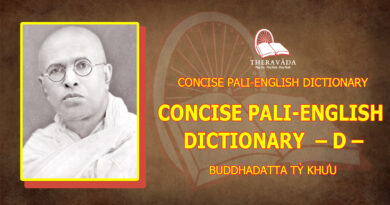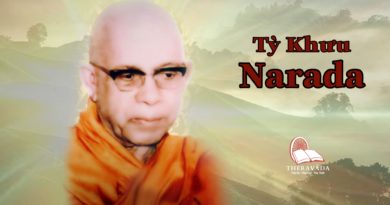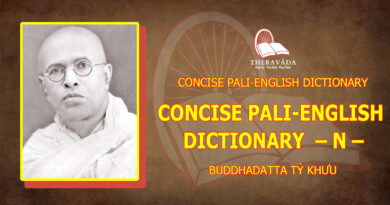VIPASSANA MEDITATION COURSE – CHAPTER 1: PRELIMINARY STAGE
MAIN CONTENT
VIPASSANA MEDITATION COURSE – CHAPTER 1: PRELIMINARY STAGE
Today we start our Vipassana Meditation Retreat: mental training, or mental development. Why should we train our mind? Because we want to free it from all kinds of mental distortions such as greed, hatred, anger, stresses, strains, and despair. When our mind is free from all kinds of these mental distortions we can live blissfully and peacefully. Thats why we have to train our mind, by means of Vipassana meditation or insight meditation.
Part 1 – Samatha And Vipassana Meditation
There are two types of meditation in Buddhism. One is Samatha meditation; the other is Vipassana meditation. Samatha here means concentration. Vipassana here means insight or experiential knowledge of bodily and mental phenomena. Of these two types of mental training Samatha meditation is practised to attain higher concentration of the mind, peaceful and blissful living and the cessation of suffering. Vipassana meditation is practised to attain not only deep concentration of the mind but also liberation from all kinds of mental and physical dukkha or suffering, through realisation of our body mind processes and their true nature.
As I explained to you, Samatha meditation is practised to attain higher concentration of the mind. So when you practise Samatha meditation, the first type of mental training or mental culture, you have to concentrate your mind on a single object of meditation. You want to concentrate your mind on a single object very deeply. That object may be a concept or observed reality, but most Samatha meditative objects are concepts. There are also a few objects which are observed reality as the object of meditation in the first type of training and Samatha meditation. But whatever the object may be the aim of Samatha meditation is to obtain deep concentration of the mind, or the higher concentration of the mind.
So you have to take a single object and focus your mind on it. When you focus your mind on this object gradually the mind will be concentrated on it very deeply. But in the beginning of the practise your mind may go out or wander. Your mind doesnt stay with the object always. Sometimes it just goes out and thinks about something else. It wanders and goes astray. Then you have to bring the mind to the object and focus it on that object again and again. Whenever the mind goes out you bring it back and focus it on the object of meditation. In this way your mind gradually becomes concentrated well on the object of meditation.
As you have practised it for some days or months the concentration becomes better and better, deeper and deeper. Finally the mind is absolutely concentrated on the object of meditation as its absorbed into the object of meditation. Such a state of mind which is absorbed into the object of meditation is called jhana, or apana in Pali. Jhana means fixed as, or absorption. When the mind is totally fixed to the object of meditation its called jhana, fixed mind. And also it is called absorption, apana.
Jnana has four stage, or five stages, in accordance with the teaching of the Buddha. So, the second stage of jhana concentration becomes better than the first. Then the third stage, the concentration better than the second. So with the fourth. As long as the mind is deeply concentrated on the object of meditation its free from all mental impurities such as desire, greed, lust, hatred, anger, ignorance, and jealousy. Because there are no impurities in the mind which is absorbed into the object of meditation you feel happy and peaceful, and calm and tranquil. Tranquillity, serenity and calmness is the result of Samatha meditation.
But in ancient times there were some devotees who practised Samatha meditation with a view to obtaining supernormal powers such as clairvoyance and clairaudience. These supernormal powers can be attained based on all the four jnanas, of the four stages. When a meditator is skilled in entering any stage of jnana he can then proceed with his meditation in order to attain psychical or supernormal powers. But though he may be able to attain them through the four stages of jnana, concentration, he is not able to rightly understand the intrinsic nature of mental and physical phenomena. He is not able to destroy any mental defilement because the purpose of Samatha meditation is to obtain deep higher concentration of the mind and psychical or supernormal powers. Because he is not able to uproot any of the mental defilements such as anger, hatred, desire, and craving, he cannot get free from all kinds of suffering, mental or physical, because these mental defilements are the causes of the suffering, dukkha. As long as one can uproot or exterminate these mental defilements, mental impurities, he is subject to suffering, dukkha.
The aim of Vipassana meditation is to free oneself from all kinds of dukkha, mental suffering and physical suffering, through realisation of the body mind processes and their true nature. So if you are able to realise mental and physical phenomena as they really are you can do away with all kinds of mental impurities or mental defilements which arise dependent on misunderstanding or ignorance of mental and physical phenomena and their true nature. Thats why we have to practise Satipatthana Vipassana meditation, insight meditation.
But you may practise Samatha meditation with a view to gaining some deep concentration on which your insight knowledge is built. Such a kind of Samatha meditation is more beneficial than that which I explained to you for the purpose of higher concentration and supernormal powers. So in ancient times, in the time of the Buddha some meditators developed Samatha meditation further, first of all so they could gain some degree of concentration such as access concentration, and if was possible jnana concentration or absorption concentration. When they had attained absorption concentration or jhana concentration they made this the basis for Vipassana meditation or Insight Meditation.
Here access concentration means that neighbouring concentration to jnana concentration. When you have attained access or neighbouring concentration you are sure to attain jnana concentration, absorption concentration, in a short time. If the purpose of a meditator is to practise Vipassana meditation based on excessive concentration he or she can attain this by means of Samatha meditation. Such kind of Vipassana meditation is known as Vipassana meditation or insight meditation preceded by Samatha meditation.
So Vipassana meditation is of two types: The first, Vipassana meditation, insight meditation is preceded by Samatha meditation. The second is the pure Vipassana meditation or insight meditation not preceded by Samatha meditation. The first type of Vipassana meditation or Insight Meditation is practised by those who have ample time to devote to their meditation. They have to spend maybe three or four months on Samatha meditation. And when they are satisfied with their attainment of jhana concentration they proceed with Vipassana meditation.
Pure Vipassana meditation is practised by those who havent enough time to devote to their meditation like yourselves, because you do not have three or four months or six months or a year for your meditation. So you can spend about ten days on your meditation. For such meditators pure Vipassana meditation is suitable. Thats why we have to conduct a ten days Vipassana meditation retreat. Actually ten days meditation is not enough. The period is too short a time for a meditator to succeed in any noticeable experience in his meditation. But there are some who have some experience in Vipassana meditation who when their meditation experience becomes major can attain the higher stages of insight knowledge of the body mind processes of their true nature. Although you can spend just ten days on your meditation, if you strive to attain the deep concentration with a strenuous effort without much interval or break in the course of your meditation for the whole day, then you are able to have some new experience of meditation. So the point is to practise intensively and strenuously as much as you can.
Part 2 – Preparatory Stages
Before you practise insight meditation there are some preparatory stages you should go through. The first the Pali scriptures mention is when one has spoken contemptuously or in jest or malice to or about a noble one – a puggala in Pali – who has attained some state of sanctity or enlightenment in accordance with the teaching of the Buddha. Then he should apologise to the Buddha. He should apologise that noble one, a puggala. If he is not available here, if he is deceased, he should make apology through his meditation teacher. I think you need not do this because you may not have spoken ill of any noble one, a puggala, because you may not met such a person in Australia.
The second stage is that you should entrust yourself to the Lord Buddha who teaches the technique of Vipassana meditation, by interesting yourself in the Buddha you can go through your course happily and peacefully. Though you may have unwholesome or dreadful visions in your meditation you wont fear them because you have entrusted yourself to the Buddha. Also you have to place yourself under the guidance of your meditation teacher so he can frankly instruct you without any hesitancy. If you do not place yourself under the guidance of your teacher he may not be reluctant to instruct you even though you have some defects in your practise.
Part 3 – Four Protective Meditations
When you have done this you should develop the Four Protective Meditations for some minutes. These four are (1) recollection of the Buddhas attributes; (2) development of loving kindness or metta towards all living beings; (3) reflection upon the loathsome nature of our body; (4) reflection on the nature of death.
When you recollect the attributes of the Buddha you can select one of nine attributes. Out of these nine attributes of the Buddha you can choose the first or the second or any of the nine as the object of your meditation and reflect on it. Here Arahat is the first attribute. Arahat means the Buddha who is worthy of honour because he has completely destroyed all mental activities and attained to the cessation of all kinds of dukkha. You have to recollect this achievement of the Buddha, thinking about its meaning. Thats the worthiness of honour through his attainment of the cessation of all kinds of suffering by destroying all mental defilements so he lived in peace and bliss and happiness. When you recollect these attributes you feel happy and brave to face any kind of dukkha or suffering in the course of your meditation as well as in your daily life. This must be done about two minutes.
Then you have to develop your metta, loving kindness, the feeling of loving kindness towards all living beings, wishing all living beings peace and happiness, and free from all kinds of mental and physical suffering, dukkha. This feeling of detached love is developed in yourself. Then you feel happy and tranquil, your mind easily concentrated on any object of meditation. This must be done about five minutes.
After that you have to reflect upon the loathsome nature of the body, thinking about its repulsiveness such as blood, pus, phlegm, intestines, and so on. This body is full of these impurities and repulsiveness. The result is you are detached from this body to a certain extent because you find it loathsome or repulsive. This also must be done about two minutes.
Then after that you should reflect upon the nature of death. Life is uncertain, death is certain. Life is precarious and death is sure. Everyone who is born is subject to death. So all men are mortal. In this way you have to think about the surety of death for every living being. You can arouse strenuous effort in your practise by thinking, `Ill have to practise this meditation strenuously before I die, or before I am dead.
This is what the Buddhist meditational texts mention as a preliminary stage for both the Samatha meditator and Vipassana meditator. They are not compulsory, not indispensable. But the texts mention they should be done. These four protective meditations, recollection of the Buddhas attributes and development of loving kindness, metta, towards all living beings is the most important thing for a meditator to pacify his distracted mind and also to practise meditation happily and peacefully.









